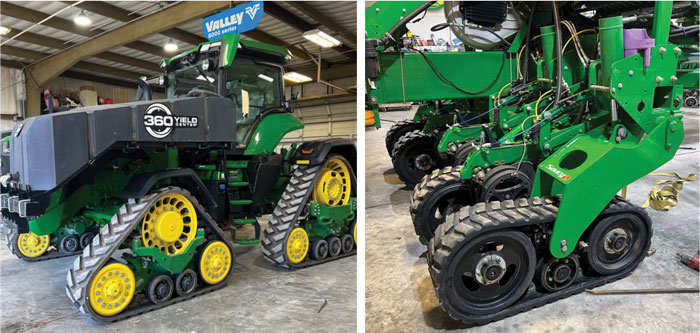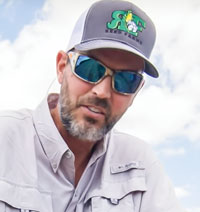I’m a first-generation farmer on the Tennessee/Alabama border. I’ve finished 1st in multiple NCGA yield contests in both states and hold the Alabama dryland record of 316 bushels of corn per acre. People ask me, “Eric, how did you figure all this out?”
There was no playbook for what I was doing when I started growing corn. I’m originally a cotton farmer. My wife and I own a cotton gin. Grain was foreign to us, but we started growing it for rotational purposes 9 years ago. My first corn yield in 2015 was 170 bushels per acre. In 2019, I was up to 260 bushels per acre.
Now, I disclose everything I learn on a YouTube channel called Crop Critic because I would have given anything in the world if just one person would’ve said, “Eric, I’ll show you how to do it” back when I started farming. I want to teach the farmer who thinks they can’t make strip-till work because of financials, equipment or poor soils that they can do this.
High Yields on Poor Soils
Our soil is as red as can be, and I’m not exaggerating. When NASCAR builds a racetrack, guess where they get the dirt? Our county built 5 schools. We sold them the dirt to build the schools on. We’re growing 350-bushel corn consistently with no irrigation and less than 1% soil organic matter.
As I was driving up to the National Strip-Tillage Conference in Bloomington, Ill., I was looking out the window like a little kid, just drooling at the soil. If I can grow 350-bushel corn on red dirt like mine with no water, there’s no telling what I could do with yours, I thought.
I farm 1,500 acres by myself, and I can’t afford a custom strip-till guy, so I use an inline ripper as a cheap way to strip-till and alleviate compaction. I like to make strips in the fall to get that nice fracture in the soil, but it often depends on how much time I have. When I get done with grain harvest, I jump right into cotton harvest. We gin about 56,000 bales of cotton a year.
Choose the Right Hybrids
A lot of hybrids fail because you make them fail. We have choices, and the choices we make have consequences. You make a bad choice on the street, you go to jail. You make a bad choice with hybrid selection, you fail.
Each of our farms gets a different hybrid. We rate our farms every year before we start. We categorize them 1 to 5 on a whiteboard in our shop office. We rate them on fertility, soil, disease, insect pressure, erosion and whatever else I can think of off the top of my head. Then we study the hybrids that are available and figure out which ones are going to work best in each environment.
“You make a bad choice with hybrid selection, you fail…”
High yields are a product of plants per acre. My average population for corn is 32,500 plants per acre, but when I’m trying to break a record, I bump it up over 38,000. We range anywhere from 29,000 on our lowest production fields to as high as 38,500 on our best fields. Push the limits of these hybrids. But believe me, if you’re going to plant 38,500, you better have 38,500 worth of plant food out there or it’s going to fail.
Feed the Crop
Draw a baseline for your fertility from soil samples. I advise you to pull your own samples because you know the hotspots and the weak spots in your fields better than anyone else. Don’t depend on anybody but yourself. After I started pulling my own soil samples, I realized how easy it was.
You’re leaving a lot of meat on the bone if you don’t have in-furrow and 2-by-2 on the planter. 2-by-2 lets you separate nitrogen (N) applications throughout the year. Corn needs very little at planting. I want just enough so the corn plant isn’t stressed at V5. For soybeans, I apply 20 units of N at planting. Soybeans do not make enough N on their own to reach the high yields we’re trying to obtain.
I don’t believe in dry fertilizer. It’s toxic to the soil. Dry fertilizer belongs on the dinner table as a form of salt. Mix some salty, hot water in a bottle. Pour the water out on your lawn, and write your name with it as you’re pouring. Go back 3 days later, and guess what happens? The grass is dead. I started managing my salts 2 years ago, and my yields went up, up, up.

STAYING ON TRACK. Eric Reed says compaction is the most overlooked yield robber. He uses tracks on his planter and tractor to alleviate compaction when planting. Photo by: Eric Reed
We band 100% of our nutrients, using either liquid 32% or 28%. Even where we band nutrients behind the planter, we come back 4-6 days later and can see where it kind of messed up the microbials. I’ll sacrifice that, but I’m not sacrificing my whole field by spreading fertilizer all over it. I’d rather have it concentrated in a band. I tell people all the time that I farm 6 inches. We’re on 30-inch rows. We run the inline ripper with RTK, come back with the planter on a stale seedbed and those corn roots have nothing but loose channels to grow straight down in.
We’re also blessed to have about 70 chicken houses by our operation. I’ll buy anywhere from 7,000-8,000 tons of chicken litter a year and broadcast anywhere from 1-4 tons on a field, depending on what it needs. The chicken litter can make a bad farm look good.
Control the Controllable
Planter prep is the most important step. If you get that step wrong, you will pay for it. An old timer once told me, “If you’re going to screw up somewhere, screw up somewhere else, not with planter prep.” That will stick with me until the day I die. Make sure there’s nothing stuck in your seed tubes. A couple years ago, one of our guys accidentally dropped a little triangle bracket in the seed tube, and we didn’t notice it until the seeds were bouncing off it, causing skipping and doubling.
Proper seedbed prep is another crucial step. We’ve been running a 2600VT vertical tillage tool from John Deere that is hands down one of the best tools I’ve ever bought from them. We use it to warm the soil in the spring. You want the seedbed to be smooth and firm. Everybody thinks, “Oh man, that ground is mellow. We’re going to have a good stand here.” No, you aren’t. You’re going to have so many air pockets, and there’s no way you can beat them all out.
“Don’t give up on the crop until the bell has rung…”
Be a student of the crop, as Randy Dowdy says. The crop is telling you what it wants and needs. I don’t rely on tissue sampling because it will sometimes lead you on a witch hunt. I used to tissue sample all the time, but I got sick and tired of going out every Monday morning whether it was pouring down rain, hot or even snowing, and pulling tissue samples. Then Wednesday morning, I’d get an email saying I was low in boron, manganese or something else. I’d call Nutrien and order the nutrients. I’d spray it, but guess what? The samples showed we were still low, so we’d repeat the process all over again.
You don’t need a tissue sample to tell you how your crop is doing. If you front load nutrients early, you don’t have to chase it all year long. Be proactive. You can never play catch-up or go back in time.
I focus a lot on fungicides and stress mitigation. You never want the crop to have a bad day. I make 4 fungicide passes throughout the growing season. Don’t give up on the crop until the bell has rung. Every step of a crop’s life is crucial, and every day is a day you won’t get back.
Hoping doesn’t win championships. Guessing doesn’t win championships. Close enough doesn’t win championships. You have to know 100% for sure that you’re spot on. A lot of people say they’d rather be lucky than good. Not me. I’d rather be good. Good means you’re consistent. Luck is a one-time deal.







